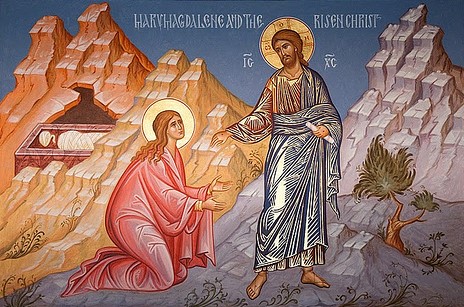
Easter
By Fr. Andrew Younan
John 20:1-18
I want to follow Mary Magdalene through this and what was going on. I want to think about how she progressed from the sadness that she had at the very beginning of the gospel to the joy that she had at the end. The reason I’m doing this is because I’m sad and we’re sad and there’s a lot to be sad about, and I want to see how she dealt with her sadness and how Christ interacted with her in this sad moment. First, I want to point out she was not in responding to her sadness, she didn’t pretend she wasn’t sort of passive-aggressive with herself, she didn’t say everything is fine, I’m fine this is not a big deal, I’m not scared, I’m not angry, I’m not upset. No, she admitted it and she faced it and she went to the tomb. She was crying and that sort of very initial first step of honesty with herself she admitted that she was upset and I think that’s the first place to start. She also didn’t let that admission throw her into despair or into giving up. She didn’t say I’m so sad I have lost the one who I thought would be the Messiah, therefore, I give up on everything. She was sad, she was weeping, and yet she went to the tomb.
In fact, this is the second time she went she went in the morning when she saw the tomb empty she ran and told the disciples. She told Peter and and John and then she went back to the tomb and so her sadness didn’t cause her to give up nor did it cause her to distract herself. These are all temptations that we have when we’re sad, we can pretend that everything is fine, that’s one way we deal with it rather than face the pain we can deal with it. In a way that causes us to completely despair it, to give up, or we can feel our sadness and then push back against it by distracting ourselves. I can be upset and then just jump into Netflix, video games, alcohol, drugs or all kinds of other things to block out the pain. Mary did none of these things and I think the gospel is challenging us also to not do these things.
She encounters Christ when He says her name. That is the transformation, that is where Mary’s sadness working through her wonder and peeking into the tomb, working through her interaction with her own emotions, working through her interaction with the church represented by the angels, working through the the interaction she has with Christ, though she does not know it’s him, at the end her sadness is transformed to joy because she jumps to Him and says Raboni. Look at the joy that comes out of her heart, that is a true transformation of real sadness to true joy and I think that’s what’s offered to us today on Easter. That having worked through and still working through all of the sadness and darkness of Holy Thursday and Good Friday and Holy Saturday now on Easter, that sadness can truly be transformed by the grace of Christ. I think Mary is a model for us because she worked through it in this way to show us that step by step our sadness does not have to remain sadness and can turn into the true joy of the resurrection.
https://younan.blog/2020/04/11/easter-homily-2020/

